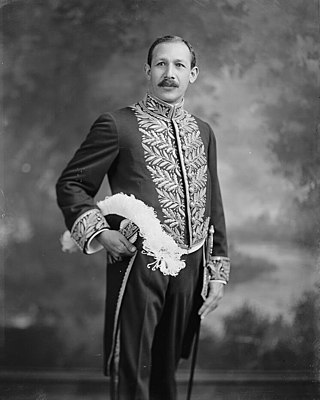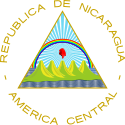Nicaragua is a nation in Central America. It is located about midway between Mexico and Colombia, bordered by Honduras to the north and Costa Rica to the south. Nicaragua ranges from the Caribbean Sea on the nation's east coast, and the Pacific Ocean bordering the west. Nicaragua also possesses a series of islands and cays located in the Caribbean Sea.

The Somoza family is a political family which ruled Nicaragua for forty-three years – from 1936 to 1979. Their family dictatorship, founded by Anastasio Somoza García, was continued by his two sons Luis Somoza Debayle and Anastasio Somoza Debayle. Anastasio Somoza García served as the President of Nicaragua from 1937 until 1956. He was succeeded by his elder son, Luis Somoza Debayle, who held the presidency from 1957 to 1963. The younger Somoza son, Anastasio Somoza Debayle, had two presidential terms: 1967–1972 and 1974–1979. Although the Somozas did not hold the presidency for the full forty-three years, they continued to rule through puppet presidents and via their control of the National Guard.

Anastasio Somoza García was the leader of Nicaragua from 1936 until his assassination in 1956. He was officially the 21st President of Nicaragua from 1 January 1937 to 1 May 1947 and from 21 May 1950 until his assassination on 29 September 1956, ruling for the rest of the time as an unelected military dictator. He was the patriarch of the Somoza family, which ruled Nicaragua as a family dictatorship for 42 years.

Emiliano Chamorro Vargas was a Nicaraguan military figure and politician who served as President of Nicaragua from 1 January 1917 to 1 January 1921. He was a member of the Conservative Party.
La Prensa is a Nicaraguan newspaper, with offices in the capital Managua. Its current daily circulation is placed at 42,000. Founded in 1926, in 1932 it was bought by Pedro Joaquín Chamorro Zelaya, who had become editor-in-chief. He promoted the Conservative Party of Nicaragua and became a voice of opposition to Juan Bautista Sacasa, for which the paper was censored. He continued to be critical of dictator Anastasio Somoza García, who came to power in a coup d'état.

Juan Bautista Sacasa was the President of Nicaragua from 1 January 1933 to 9 June 1936. He was the eldest son of Roberto Sacasa and Ángela Sacasa Cuadra, the former's cousin twice removed. He was a relative of Benjamín Lacayo Sacasa.

The Conservative Party was a conservative political party in Nicaragua. Its slogan was "Dios, Orden, Justicia", often depicted on the three sides of a triangle.

General elections were held in Nicaragua on September 1, 1974, to elect a president and National Congress of Nicaragua.

General elections were held in Nicaragua on 2 February 1947 to elect a president and National Congress.

Constitutional Assembly elections were held in Nicaragua on 3 August 1947.

Presidential elections were held in Nicaragua on 15 August 1947.

General elections were held in Nicaragua on 8 December 1936 to elect a President, half of the Deputies and one-third of the Senators of the National Congress.

Constitutional Assembly elections were held in Nicaragua on 6 November 1938.
The elections held on 6 November 1938 were even more of a sham than those that named Anastasio Somoza García president in 1936. The Conservatives decided to abstain again, while the ballot boxes and ballots were distributed throughout the country by the quartermaster general of the Guardia Nacional. The final results were made available within twenty-four hours. In 1938 the Genuino Conservatives decided to field candidates for the Constituent Assembly although the Conservative party’s leadership vehemently opposed the plan.

General elections were held in Nicaragua on 6 November 1932 to elect the president, half of the seats in the Chamber of Deputies and one-third of the seats in the Senate of the National Congress.

Presidential elections were held in Nicaragua on 9 June 1936.

Presidential elections were held in Nicaragua on 11 November 1926.

General elections were held in Nicaragua on 5 October 1924 to elect a president, half of the deputies and one-third of the senators of the National Congress.

General elections were held in Nicaragua on 3 October 1920 to elect a President, half of the Deputies and one-third of the Senators of the National Congress.

General elections were held in Nicaragua on 6 October 1916 to elect a President, half of the Deputies and one-third of the Senators of National Congress of Nicaragua.

The Traditional Conservative Party, was a Nicaraguan political party founded in the first half of the 19th century as the Conservative Party.






